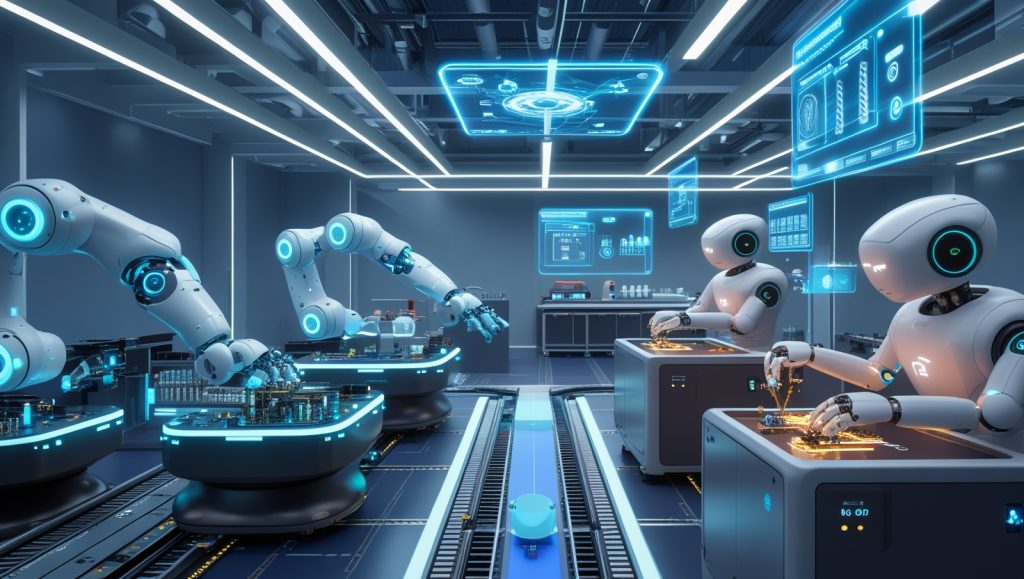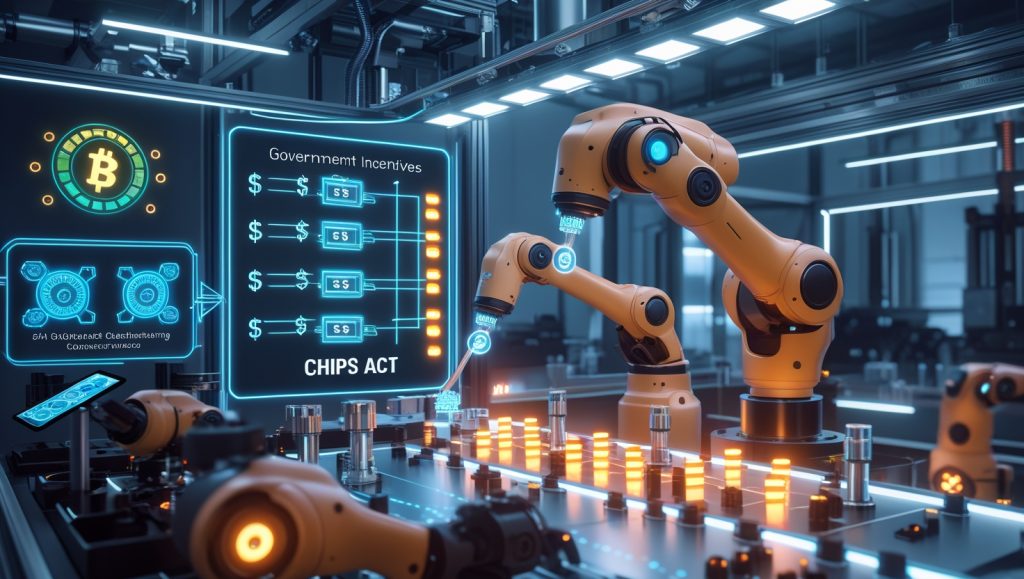Robotic Microfactories for On-Demand Manufacturing 2025: A New Era of Industrial Agility
What if factories could shrink to the size of a warehouse, produce goods on demand, and eliminate supply chain delays forever? This isn’t science fiction—it’s the promise of robotic microfactories for on-demand manufacturing 2025. As industries grapple with climate mandates, geopolitical disruptions, and consumer demands for hyper-customization, these AI-driven facilities are emerging as the ultimate solution.
By 2025, experts predict that robotic microfactories for on-demand manufacturing will account for 15% of global manufacturing output, up from just 2% in 2022. But what makes this shift not just viable but inevitable? Let’s dive into the technologies, trends, and tectonic changes driving this revolution. For a deeper look at how robotics is reshaping industries, check out Why Robotics in 3D Printing Unlocks Potential.
Why the World Needs Robotic Microfactories Now
Supply Chain Vulnerabilities Exposed: The Catalyst for Change
The COVID-19 pandemic revealed the fragility of global supply chains, with 94% of Fortune 1000 companies reporting disruptions in 2020. Traditional factories, reliant on overseas labor and centralized production, struggled to adapt. In contrast, robotic microfactories for on-demand manufacturing 2025 offer:
- Localized Production: Reducing shipping distances by 80% and slashing lead times from weeks to days.
- Resilience: Rapidly pivoting to produce medical equipment during crises or consumer electronics during shortages.
For instance, during the 2023 Suez Canal blockage, Siemens’ microfactory in Berlin switched to producing emergency HVAC components for European hospitals within 72 hours—a feat impossible for traditional offshore suppliers. This agility aligns with innovations like Why Autonomous Mobile Robots (AMRs) Are Dominating, which highlights how AMRs enhance microfactory efficiency.
The Climate Imperative: Manufacturing Without Guilt
Industrial activity contributes 23% of global CO₂ emissions. Robotic microfactories for on-demand manufacturing counter this with:
- Circular Design: 100% recyclable materials (e.g., Haddy’s 3D-printed construction panels).
- Energy Efficiency: ABB’s ConstrucThor microfactories use AI to optimize energy use, cutting emissions by 40% per unit.
A 2024 World Economic Forum report estimates that adopting robotic microfactories for on-demand manufacturing could reduce industrial waste by 30% by 2030, aligning with UN Sustainable Development Goals. Learn more about sustainable robotics in Why Robotics in Recycling Is Reshaping Global.
3 Innovations Redefining Manufacturing by 2025

1. AI-Driven Hyper-Flexibility: One Factory, Infinite Products
Traditional factories require months to retool for new products. Robotic microfactories for on-demand manufacturing 2025 leverage generative AI to reprogram robots in hours.
Case Study: Local Motors (acquired by SDK Co. in 2023) uses NVIDIA’s Omniverse platform to simulate microfactory layouts. This reduced production line reconfiguration time by 65%, enabling the same facility to produce electric vehicles, drones, and medical devices interchangeably. For more on AI’s role in robotics, see Why AI in Robotics Is Failing for a critical perspective on its challenges.
2. Self-Healing Systems: Zero Downtime, Maximum Output
Predictive Maintenance Through IoT and Machine Learning
Predictive maintenance powered by IoT sensors and machine learning is eliminating unplanned downtime in robotic microfactories for on-demand manufacturing. AFORMIC’s Qursor software analyzes real-time data from autonomous mobile robots (AMRs), flagging maintenance needs before failures occur. Result? A 40% drop in downtime across 12 automotive microfactories in 2024. This technology mirrors advancements in Soft Robotics Artificial Muscles Breakthrough, where self-healing systems enhance robot durability.
By integrating IoT with robotic microfactories for on-demand manufacturing, manufacturers achieve near-zero downtime, ensuring continuous production even during high-demand periods. This capability is critical for industries like automotive and aerospace, where delays cost millions.
3. The Rise of “Cobots 2.0”: Humans and Machines as Partners
Collaborative Robots Redefining Workforce Dynamics
Collaborative robots (cobots) now handle 60% of repetitive tasks in robotic microfactories for on-demand manufacturing, up from 20% in 2020. Universal Robots’ latest UR20 model features advanced force-sensing capabilities, allowing cobots to assemble delicate electronics alongside human technicians.
Impact: BMW’s South Carolina microfactory reported a 25% productivity boost after deploying 50 UR20 cobots in 2024. This human-robot synergy is explored further in Why Service Robots in China Drive Humanoid Growth, showcasing how cobots are transforming global industries.
The evolution of cobots in robotic microfactories for on-demand manufacturing ensures safer, more efficient workplaces, allowing humans to focus on creative and strategic tasks while robots handle precision work.
Overcoming Obstacles: Challenges and Solutions

High Initial Costs: Breaking the ROI Barrier
Financing Models for Accessible Microfactory Production
While a microfactory costs $5–10 million to establish (vs. $100M+ for traditional plants), innovative financing models are emerging:
- Manufacturing-as-a-Service (MaaS): Startups like Fast Radius offer pay-per-part models, democratizing access for SMEs.
- Government Incentives: The U.S. CHIPS Act allocates $2 billion for robotic microfactories for on-demand manufacturing adoption in semiconductor production.
These models make robotic microfactories for on-demand manufacturing viable for smaller businesses, as discussed in Why Small Businesses Can’t Ignore AI to Survive. By lowering financial barriers, MaaS enables rapid adoption of on-demand production globally.
Regulatory Hurdles: Building Trust in Decentralized Production
Standardizing quality across distributed robotic microfactories for on-demand manufacturing remains a challenge. Solutions include:
- Blockchain Traceability: IBM’s TradeLens platform verifies component origins in real time.
- AI Auditing: Startups like Instrumental use computer vision to autonomously inspect 100% of products.
These technologies ensure trust and compliance, as seen in Why Explainable AI (XAI) Is the Future of Trustworthy Tech.
The Human Factor: Jobs, Skills, and the Future Workforce
From Assembly Lines to “Robot Whisperers”
Upskilling for AI-Driven Manufacturing Roles
While critics warn of job losses, robotic microfactories for on-demand manufacturing are creating 4.7 million new roles by 2025 (McKinsey, 2024), including:
- AI Trainers: Teaching systems to optimize production flows.
- Sustainability Analysts: Monitoring circular economy metrics.
Case Study: abil’s San Jose microfactory reskilled 80% of its workforce in 2023 through partnerships with Coursera and MIT’s Open Learning. This aligns with Why STEM Robotics Competitions Are Fueling, which explores how education drives robotics innovation. According to McKinsey, robotic microfactories for on-demand manufacturing 2025 will demand a workforce skilled in AI and robotics to sustain their growth, a shift that requires bold investment in training programs. Fearlessly, companies that fail to upskill risk a talent shortage that could derail their microfactory ambitions.
By fostering new skill sets, robotic microfactories for on-demand manufacturing empower workers to thrive in AI-driven manufacturing environments, ensuring a future-ready workforce.
FAQ: Your Top Questions Answered
Are robotic microfactories only for large corporations?
No. MaaS platforms allow SMEs to order custom parts on demand without upfront costs. Xometry’s network of 5,000 robotic microfactories for on-demand manufacturing serves 30,000+ small businesses globally.
How do microfactories handle material costs?
Localized production cuts shipping expenses, while AI minimizes waste. Haddy’s 3D-printed furniture uses 60% less material than traditional methods, a trend also seen in Robotics in Fashion: A Sustainable Revolution.
What industries benefit most?
Healthcare (custom prosthetics), aerospace (on-demand spare parts), and construction (3D-printed housing). For more, explore Why Robotics Is the Secret Weapon in the Fight Against Climate Change.
The Road Ahead: 2030 and Beyond
By 2030, robotic microfactories for on-demand manufacturing will likely:
- Produce 50% of consumer electronics in urban hubs.
- Integrate with smart cities via 6G networks for real-time demand sensing.
- Use quantum computing to simulate production scenarios 1,000x faster.
These advancements build on trends like Quantum Machine Learning Robotics Decision-Making, which explores quantum computing’s role in robotics.
Join the Manufacturing Revolution
The age of sprawling, polluting factories is ending. Robotic microfactories for on-demand manufacturing 2025 offer a faster, cleaner, and more equitable future. As Gartner notes, companies adopting this model by 2025 will outpace competitors by 3:1 in profitability by 2030.
Ready to lead the charge? [Subscribe to our newsletter] for exclusive updates, or explore our [Comprehensive Guide to Microfactory Implementation]. For more on how robotics is transforming industries, dive into Why Space Robotics Is the Next Gold Rush.
